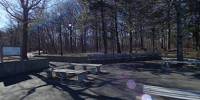
Fort Lee - Border Between New York and New Jersey
Fort Lee, New Jersey, USA
March 15, 2006, 3 PM
© 2006 Carlton SooHoo, Ph.D., All Rights Reserved.
Fort Lee
From: http://www.njpalisades.org/flhp.htm
Fort Lee found its place in American history during the 1776 British campaign to control New York City and the Hudson River.
After the siege of Boston, George Washington turned his attention to the defense of New York City and the Hudson River Valley. Along with the construction of fortifications at the City and Long Island, Washington felt it imperative to build and strengthen his defenses along the Hudson River.
The British plan was to control the length of the Hudson with the overwhelming dominance of its Royal Navy. The plan, if successful, would split the Colonies in half and, it was hoped, bring an early end to the American rebellion.
In July of 1776, work was begun on this site, which was first named “Fort Constitution.” The name was later changed to “Fort Lee,” to honor General Charles Lee, whose army had achieved a major victory at Charleston, South Carolina, that summer. On the high ground of northern Manhattan opposite Fort Lee, work had by that time already begun on another fort, called Fort Washington. On July 12, Admiral Richard Howe sent two British ships, the Rose and the Phoenix, up the Hudson. Cannon fire from Fort Washington had had little effect on their passage; Washington ordered work on Fort Lee to continue as quickly as possible.
At Major General Israel Putnam’s suggestion, vessels were sunk in the river channel between the forts. With these obstructions, and artillery fire from the twin forts, it was believed by the Americans that no British ships would be able to sail past without sustaining severe losses.
King George III, wanting to end the rebellion as quickly as possible, had sent the largest armada of British ships and troops ever to leave England’s shores. By mid-August, Sir William Howe, British Commander-in-Chief (and brother to Admiral Howe), had assembled an army of over 31 thousand British and Hessian troops on Staten Island.
On August 22, the British landed on Long Island and five days later forced the Americans to retreat to New York City (at the time, the City comprised only the southern tip of Manhattan Island). In September, the British took New York City and the rest of Manhattan—except for Fort Washington.
On November 16, Fort Washington fell to an overwhelming assault by British forces, who captured over three thousand American troops.
Washington, realizing that with the loss of Fort Washington, Fort Lee was of little military value, ordered General Nathanael Greene, the commander at Fort Lee, to begin preparations to evacuate the fort. An orderly withdrawal, however, was not in store for the Americans.
On November 20, just four days after taking Fort Washington, the British had Lieutenant General Cornwallis ferry five thousand men across the Hudson several miles north of Fort Lee. When word of the crossing reached Washington, he ordered an immediate retreat, before his army could be cut off and captured by the British force. Most of the American supplies and artillery had to be left behind. These were indeed among the darkest days for the American cause, leading to Thomas Paine’s famous words,
“These are the times that try men’s souls…” -----------------------------------------------------------
The George Washington Bridge is prominently seen spanning the Hudson River, connecting New Jersey and New York.
From: http://www.fortleeonline.com/gwb/index.html
The George Washington Bridge crosses the Hudson River between Fort Lee, New Jersey and Upper Manhattan in New York City, constituting a part of Interstate Highway I-95. Originally designed by Swiss-American engineer Othmar H. Ammann, then-Chief Engineer for the Port Authority, ground was broken for the original six-lane bridge in October of 1927. The bridge was first opened to traffic on October 25, 1931; however, volume required that two additional lanes be created in 1946.
As the traffic volume continued to grow, on August 29, 1962, the Lower Level was opened. This made the George Washington Bridge one of the world’s busiest bridges and the world’s only 14-lane suspension bridge. In 1981, the American Society of Civil Engineers designated the GWB as a National Historic Civil Engineering Landmark.
Two 3-lane approach and departure roadways serve the Lower Level, with connections to and from the GWB via two 3-lane tunnels through the Palisades. Two 4-lane approach and departure roadways connect to the Upper Level. New Jersey approaches to both levels of the Bridge include US-1, US-9W, US-46, NJ-4, I-80, I-95, and the Palisades Interstate Parkway.
Lat: 40° 51' 0" N
Long: 74° 58' 50" W
Precision is: Medium. Nearby, but not to the last decimal.


 Tap or click the zoom icon in the bottom right corner of the picture to switch between in-page and fullscreen view
Tap or click the zoom icon in the bottom right corner of the picture to switch between in-page and fullscreen view